
Research Article Volume 10 Issue 4
How quarantine and social distancing policy can suppress the outbreak of novel coronavirus in developing or under poverty level countries: a mathematical and statistical analysis
Atiqur Chowdhury,1 
Regret for the inconvenience: we are taking measures to prevent fraudulent form submissions by extractors and page crawlers. Please type the correct Captcha word to see email ID.

K M Ariful Kabir,2 Jun Tanimoto3
1College of Business, Economics, Applied Statistics and International Business, New Mexico State University, USA
2Interdisciplinary Graduate School of Engineering Sciences, Kyushu University, Japan
3Department of Mathematics, Bangladesh University of Engineering and Technology, Bangladesh
Correspondence: Atiqur Chowdhury, College of Business, Economics, Applied Statistics and International Business, New Mexico State University, USA
Received: September 16, 2021 | Published: November 3, 2021
Citation: Chowdhury A, Kabir KMA, Tanimoto J. How quarantine and social distancing policy can suppress the outbreak of novel coronavirus in developing or under poverty level countries: a mathematical and statistical analysis. Biom Biostat Int J. 2021;10(4):145-152. DOI: 10.15406/bbij.2021.10.00341
Download PDF
Abstract
In this paper, we develop a novel theoretical model named “Social distancing SEIQR model” to control the spread of infection by combining both quarantine and social distancing explicitly based on the real cases that observed where medical equipment and others resources are limited. COVID-19 is a transmissible viral disease that has rapidly stroke around the world and is currently a major thread for the developing countries. The basic reproduction number of infectious disease dynamics model is very effective tools as a threshold quantity in the epidemiology context. To validate our model, a linear regression polynomial fit analysis has been studied and fitted our simulated data with the original data. A high percentile values established our model to analyze the future situation for Bangladesh with strong confidence. For that, we have analyzed the basic reproduction number mathematically and statistically, then discuss our findings and shown our model is an outstanding model to make a decision which situation is good for developing country like Bangladesh or under poverty level countries to stop the COVID-19 coronavirus from spreading.
Keywords: novel coronavirus, mathematical model, basic reproduction number, next generation matrix, transmissibility
Introduction
Novel coronavirus was named as SARS-CoV-2 is a transmissible viral disease that has rapidly stroke around the world1-4 and is currently a major thread for developing and under poverty level countries by the World Bank and WHO’s prediction. A country like Bangladesh where population density is much higher is in high risk of increasing the reproduction level of this coronavirus much faster than other developed countries like the U.S.A, China, Japan, Canada, Germany, United Kingdom etc.5,6 Without inventing vaccination or the proper treatment, how we control a faster infectious disease like SARS-CoV-2 or COVID-19 is one of the most admitted questions with which our developed civilization faces right now. At the same time, some policies termed as “isolation”, “quarantine”, “lock-down” and “social distancing” would give a stunning direction to control the epidemic outbreak.
Merging those ideas, theoretical epidemic model and analyses that give some shed of light of infectious diseases to control the risk of infection and transmission gets public attention. Therefore, the SEIQR epidemic model is deliberated to study the novel coronavirus by introducing the social distancing parameter as a case study of Bangladesh, to date, no study has been conducted.
The compartment model with mean field approximation is considered that is the most prevailing analytical aspects to understand the society-based complex epidemic dynamics. The simplest epidemic model that is denoted by SI model7 where S hold to present the susceptible individuals and I for infected people, whereas, the extended idea is designed as SIS epidemic model8 to represent the infected individual becomes susceptible again. Furthermore, SIR model:8 susceptible (S), infected (I) and recovered (R) is analyzed to explain and predict the demanding amount of vaccination, medical assistance and facilities during the epidemic period by many researchers. Correspondingly, the SEIR model9-11 (susceptible-exposed-infected-recovered) and SEIQR model (susceptible-exposed-infected-quarantine-recovered) model12 are exhibited the extended of SIR model for various diseases and situations that explained the pre-infection exposed state and the post quarantine policy.
Aside from those models, many researchers investigated epidemic model by introducing metapopulation, vaccination, information spreading and treatment.13-18 Recently, Chen et al.19 explained about Bats-Hosts-Reservoir based mathematical model for novel coronavirus that does not concerned about any provisions to suppress the pandemic. Additionally, the area of such various studies has been extended by many investigators to incorporate exposed and quarantine provisions to protecting minimize the risk of infection.20-25 In this paper, we develop a novel theoretical model named “Social distancing SEIQR model” to control from spreading the COVID-19 coronavirus by combining both quarantine and social distancing cases explicitly based on the real cases that observed in Bangladesh.
The paper is organized as follows. First, we introduce a method and model in detail. This is followed by estimating parameters and analyzing the reproduction number. Then, we investigate the proposed model through numerical and statistical analytical simulation. Finally, the concluding notes include some restriction and further discussion of our findings are provided.
Method and Model
Method
We introduce a modified infectious disease dynamics model (SEIR model) by introducing the quarantine (Q) and social distancing situation for the purpose of modeling and preventing from spreading the COVID-19 coronavirus.
To formulate the model into the modified SEIR model we assumed no animal to human transmission has been introduced in Bangladesh. Our assumption is based on the situation that COVID-19 coronavirus brought into Bangladesh from abroad. No one is sure from whom it is spreading in Bangladesh. As of now, according to Institute of Epidemiology, Disease Control and Research (IEDCR)6 there are 48 peoples of Bangladesh are found COVID-19 coronavirus positive where six suspected persons has been died. They claimed among those 48 positive cases there are 32 persons traveled to Bangladesh from different countries where major portion of these peoples either traveled in Europe or China from Bangladesh or they were reside in Europe for a long time. So, it is our major concern to heed on in-outboard travel passengers in Bangladesh in this paper. Then we will take into account what could happened if all those people were home quarantined but somehow they have connected with other peoples surrounding to him/her. What could happened if some has been finished their 14– days quarantined period but he/she might still carrying COVID-19 virus that is asymptomatic in his/her body, and he/she has been contacted with someone during these days. Finally, we will analyzed all these scenario mathematically and statistically.
Model and Data Source
The modified SEIR including quarantine (Q) situation was posted to medRxiv on 17 February, 2020.23 We assumed that the virus transmitted among the travelers who was either traveled recently in abroad from Bangladesh or who is a temporarily or permanently resident in Europe or Middle-East, and then transmitted to the Bangladeshi citizen who is closely contacted person with them. People exposed to the either governmental assigned quarantined center or in home quarantine places got the risks of the infection (Figure 1).
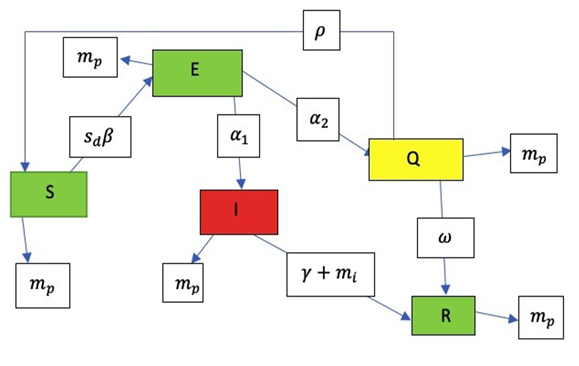
Figure 1 Flowchart of the modified SEIR dynamics for COVID-19 coronavirus in developing countries including quarantine (Q) and social distancing situation.
Parameter estimation: We named this model SEIQR social distancing model. The transmissibility of the COVID-19 based on this model was based on the following assumptions or facts:
- The people were divided into five compartments: susceptible people (S), exposed people (E), infected people (I), quarantined people (Q) (who brought virus in Bangladesh but didn’t detected at the airport), and removed people (R) that states both recovered individual who gets natural immunity at the rate of
and dead individual at the rate of
. These two parameters play different rules in our developed model and both do not affect remaining individuals in the system 2. The usual death rate of peoples are defined as
(the death rate of Bangladesh per 1000 people). In this model, we set
, where
refer to the total number of people in Bangladesh including peoples came from abroad. We also assume there are 80% infected people has been recovered by taking small treatment at local hospital and 1% infected people has been died by the COVID-19 coronavirus. Thus, in this study we have set
and
for all analysis.
- We assume that on March 7, 2020 before the first flight from Italy on Bangladesh, no was infected across the country. Government sent them to Ashkona Hajj Camp (a temporary governmental quarantine center), a medical team has checked them and found no one found COVID-19 positive. Then government sent them home with the guidance that they should stay at their home quarantine for at least 14– days. In our model we assume
where
is the probability of all those quarantined people who came from Italy in Bangladesh got infected by considering 70% of them didn’t follow governmental guidance at the beginning and came into contact with susceptive (S) people.
- At this time there are no sufficient data source for mean incubation period. So, we assume
as a rate of latent incubation period, where mean incubation days is
days because it’s very short time in Bangladesh that COVID-19 coronavirus is spreading. And,
is the latent incubation rate of those people who has been home quarantined within an average of
days as well.
- We assume
is the rate of recovered people become susceptive because after 14– days some people thought they don’t have any symptom of COVID-19 but it shows up after 14– days. But, within this time they have contacted with others people around them.
- Our main focus on the parameter
the number of % people of Bangladesh followed governmental guidance and recovered from the quarantined center or from the isolation situation. We will compare our result with the consideration of number of % people didn’t followed governmental guidance and not remained himself/herself in home quarantined for the lockdown free days.
- In this research we introduced a novel idea by introducing a social distancing parameter
in our SEIQR model. We assumed this parameter value depends on how many people are making social interaction during lockdown free days. For example, if government of Bangladesh locked the country for 7– days, and keep 23– days lockdown free, then it is likely to assume 75% will interact socially of these lockdown free days across the country. But, maybe 25% people of Bangladesh will be careful about the COVID-19 and they didn’t go out that much or they went outside but maintained social distance (at least 4 ft). On the other hand, when 7– days is lockdown during 30–days period, then people bound to kept themselves staying at home. So, we assume 90% people became very careful and kept themself at home quarantine during the lockdown days. So that,
(1)
Based on all assumption above, the mathematical model is the following:
(2)
Where,
Basic reproduction number,
:
In this study, we used the
to assess the transmissibility of the COVID-19. Commonly,
was defined as the expected number of secondary infections that result from introducing a single infected individual into an otherwise susceptible population.19-21 If
, the outbreak will occur. If
, the outbreak will toward an end. In this study,
was deduced from the equation 2 model by the next generation matrix approach.22
Based on the equations of our model, we can get the disease free equilibrium point as:
(3)
(4)
(5)
where,
(6)
(7)
where,
(8)
Using matrix 7 we can find the basic reproduction number
which is the spectral radius
of the next generation matrix
. Thus,
(9)
Using
in equation 9 and solve for
, we can estimate transmissibility rate as follows:
(10)
Results
Based on the parameter estimation as described before, first we have studied the original data for COVID-19 positive cases from March 7, 2020 to March 28, 2020. Between these days, the IEDCR’B has tested people and found 48 people have COVID-19 positive. So, we initially assume the transmissibility rate
. As of now, Bangladesh didn’t lockdown the country. So, we have assumed
and
. We assume, people didn’t become cautious yet. Hence, we assume,
,
. Also, since the country didn’t put any pressure to move around freely, we assume there are 95% population of Bangladesh are making social interaction with in various places, i.e,
. With these assumptions, we fit our simulated result with the real data.6 A linear regression polynomial fit results with
, with adjusted
(Figure 2) showed that our model fitted well to the reported COVID-19 cases data for Bangladesh. Now, using all the assumptions and the equation 9, we have estimated the value of the basic reproduction number , that means, we may say, within these
days COVID-19 coronavirus is already an outbreak in Bangladesh.

Figure 2 Simulated result compared with real data5 March 7,2020 to March 28, 2020. A linear regression polynomial fit curve used for the simulated data with R2=0.932.
Based on this result, next we will discuss how to stabilize the situation by taking some strategies for 30- days and protect the nation from spreading this virus.
|
Parameter
|
Description
|
Values
|
|
` |
Total population of Bangladesh
|
|
|
|
Death rate
|
|
|
|
Mortality rate of the infected people
|
|
|
|
Rate of infected people become recovered
|
|
|
|
Birth rate of Bangladesh
|
|
|
|
Transmissibility rate
|
|
|
|
Latent incubation rate to be infective
|
|
|
|
Latent incubation rate to be quarantined
|
|
|
|
Rate of recovered people become susceptive
|
|
|
|
Rate of quarantined people become recovered or dead
|
|
|
|
Rate of infected people become quarantined
|
|
|
|
Number of quarantined people out of 100
|
|
|
|
Number of non-quarantine dpeople out of 100
|
|
|
|
Number of Lockdown days in Bangladesh
|
|
|
|
Number of Lockdown free days in Bangladesh
|
|
|
|
Number of people making social interaction out of 100
|
|
|
|
Social distancing parameter
|
|
|
|
The multiple of the transmissibility of
to that of
|
|
Table 1 Definition of those parameters in the SEIQ R social distancing model
|
Description
|
Parameter
|
Values
|
|
Prediction
|
|
No lockdown
|
|
0.9
|
|
|
|
|
|
0.95
|
|
|
|
|
|
8.67X10-09
|
5.93
|
Outbreak
|
|
One week lockdown
|
|
0.6387
|
|
|
|
|
|
0.621
|
3.77
|
Outbreak
|
|
Two weeks lockdown
|
|
8.69X10-09
|
|
|
|
|
|
0.357
|
2.12
|
Outbreak
|
|
|
|
8.66X10-09
|
|
|
|
Three weeks lockdown
|
|
0.508
|
|
|
|
|
|
0.16
|
0.945
|
Stable
|
|
|
|
8.71X10-09
|
|
|
Table 2 Prediction regarding lockdown situation
Discussion
We are going to discuss how a developing countries in Asia or under poverty level countries in Africa can take best strategies in a
days time frame to face this COVID-19 coronavirus. Figure 2 is showing that, there is a high chance for the COVID-19 coronavirus can spread in the high number of people in Bangladesh around in mid April, 2020. So far, people already became cautious. But, still the country has many other concern to face this COVID-19 coronavirus in many levels. Suppose, there is no lockdown at any place in Bangladesh, that is assume,
and
now. Since, people have a chance to go out and make social interaction freely, we assume 90% peoples of Bangladesh will make social interaction with each other, where 10% people are self cautious and kept themself at home quarantine. Also suppose,
, the inboard passenger sent to the quarantine center and presumably they all removed from the quarantined center. From this situation, when a country has limited medical resources to test the vast amount of people of the country’s populations and provide intensive medical treatment, any third-world country can follow three well guidance provided by WHO, which are:
Case-I) Take administrative action (i.e: Applying lockdown the country)
Case-II) People’s of Bangladesh can take responsibility by themself (i.e: ensuring to maintain social distance rule by the WHO guidance)
Case-III) Ensuring the nation to stay at home (i.e: ensure peoples to keep themself either at home quarantine or governmental quarantine center)
We will show, some mathematical and statistical results that can be a direction for a third-world country to reduce the infectious number of people.
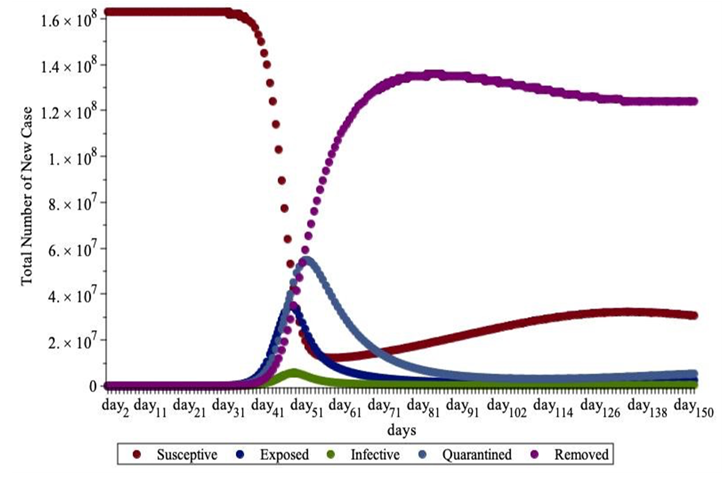
Figure 3 Based on our model we are predicting there is a chance thatCOVID-19 coronavirus will be it’s pick time to spread throughout the country after 40−days from March 7, 2020 in Bangladesh.
First, we will discuss, what administrative authority of a lower economic based country may consider to do for preventing COVID-19 coronavirus from spreading across the country. A long days lockdown can cost huge for any country, so assume a developing can’t effort economically by making lockdown the country for more than a month. However, to make situation under control, they can try to make lockdown the country from one week to three weeks. So, we now assume
, and
. The basic reproduction number
when the entire country is not lockdown yet. So that, they can think to consider to make lockdown the country for one week. Figure 4 and Table 3 shows that, seven days lockdown is not sufficient to control spreading the virus. But, as we found it may needs at least three weeks lockdown to reduce the reproduction of this COVID-19 in Bangladesh and protect the nation from affecting.
|
Description
|
parameter
|
values
|
|
Prediction
|
|
|
|
0.50
|
3.13
|
outbreak
|
|
|
|
0.40
|
2.50
|
outbreak
|
|
Zero days lockdown
|
|
0.30
|
1.87
|
outbreak
|
|
|
|
0.20
|
1.27
|
outbreak
|
|
|
|
0.10
|
0.623
|
Stable
|
Table 3 Prediction regarding maintaining social distancing by isolating the people across the country
Also, a Pearson’s correlation was run to determine the relationship between five cases (zero days, one, two, three, and complete thirty days lockdown situation) between each other. There was a very strong, positive correlation on the infective numbers between one, two, three weeks lockdown situation and complete lockdown situation. Figure 4
The Pearson’s correlation result shows that when there is a limited resources to control an outbreak, then at least three weeks lockdown the country could be a good strategy to reduce the number infection.
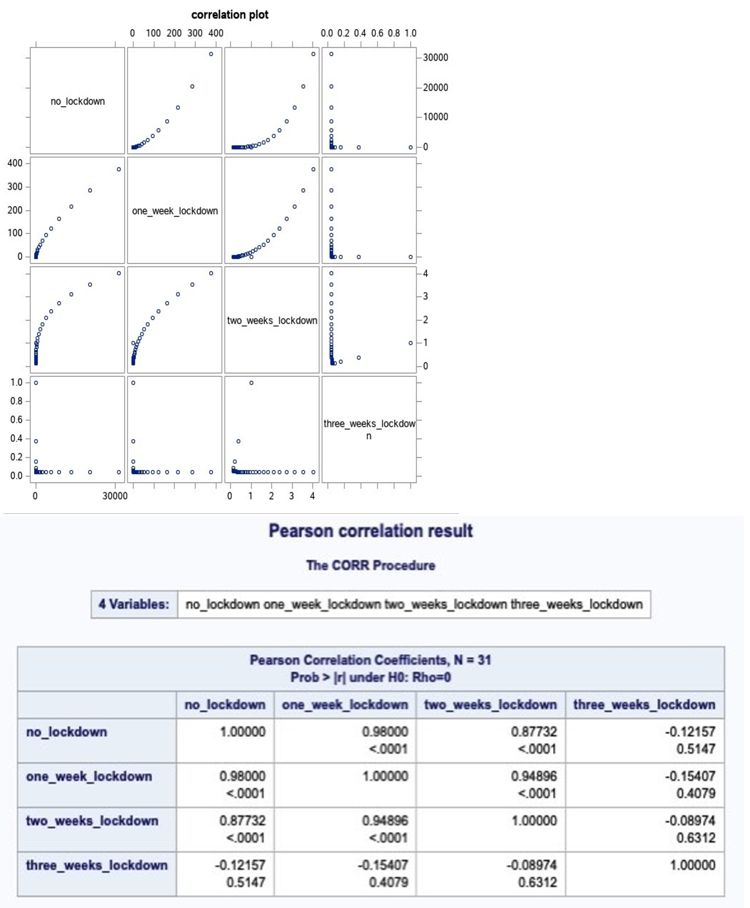
Figure 4 The Pearson’s correlation result for lockdown situation in Bangladesh. Results shows that, at zero days lockdown (Lockdown-0)versus one week lockdown (lockdown-7) situation has very strong positive correlation with p−value 0.0001. That means, if the infected number of people increases for one week lockdown, in one week lock-down situation number of infected people will increase too. But, we can also see there is a negative correlation between zero days lockdown situation and three weeks lockdown situation with high p−value, that means statistically there no significance evidence that if the number of infected people increases during the zero days lockdown time, a three weeks lockdown will also have chance to increase the number of infected persons.
But, for a developing country like Bangladesh, three weeks lockdown could put the country in the economic hardship. Especially when a country has
of people who earned less than
per-day. From this viewpoint, now we focused on decreasing the rate of social distancing parameter
. We have run our model by setting this parameter values from 0.50 to 0.10 with an interval of 0.10. That means, we are thinking during the lockdown free situation, Bangladeshi people will make social gathering on an average of 50% people at the beginning. Table-5 shows that, when an average of
peoples are making social interaction can create a massive outbreak situation for the country. On the other hand, when number of percentile of people in Bangladesh when make social interaction on an average of
can reduce outbreak of this COVID-19 in Bangladesh.
|
Description
|
Recovery rate of quarantined people
|
|
Prediction
|
|
|
10% people
|
2.47
|
outbreak
|
|
Zero
|
20% people
|
1.70
|
outbreak
|
|
days
|
30% people
|
1.35
|
outbreak
|
|
lockdown
|
40% people
|
1.14
|
outbreak
|
|
|
50% people
|
1.00
|
outbreak
|
|
|
60% people
|
0.905
|
stable
|
Table 4 Prediction regarding quarantined people become recovered person
Several authors suggests, when an epidemical disease become pandemic and especially when there is no vaccination is useful, then it is highly suggestive that sent people to the home quarantine. Researchers suggests that, using this procedure a country can increase the recovery rate.20-22 We assume Bangladesh can also follow this procedure to protect the nation from this virus. Suppose now, there are 50% probability that home quarantined peoples has become susceptive and 35% population of Bangladesh was in quarantined, and 75% peoples were making social interactions at the beginning. That is we assumes
,
and
. From this point we have used our model to find
by varying the parameter
. We have started from 10% to 60% by considering entire country is not locked officially, but the people took responsibility and made themself isolated or kept themself as a home quarantined person. Our modelling simulation shows that, it changes the result impressively. Table-6 shows that, at this time if 60% or higher people of Bangladesh kept themself at home, then COVID-19 coronavirus will become week to reproduce the virus in the human to human body.
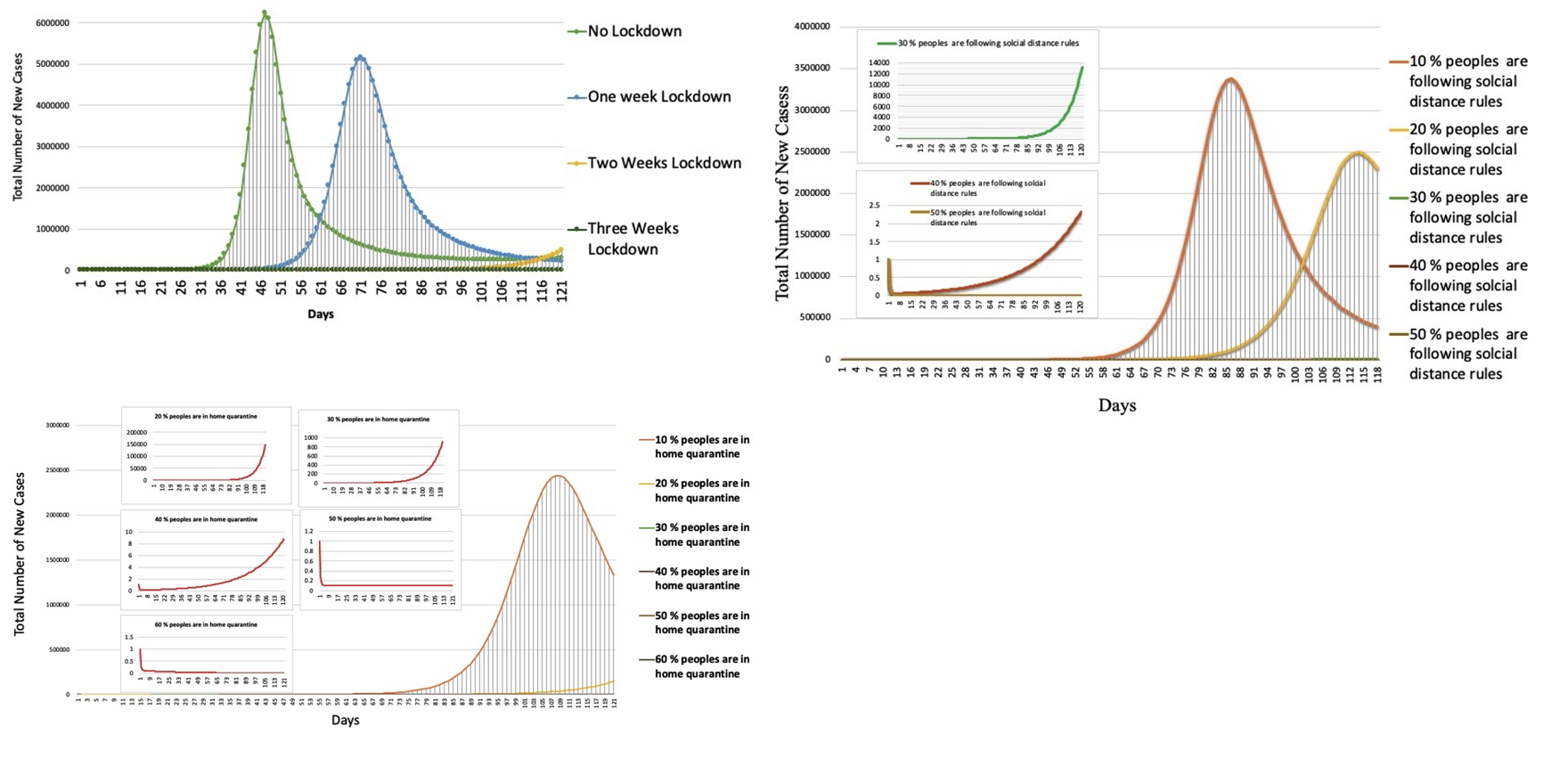
Figure 5 (top) Based on our model showing the result for Case-I. (middle) showing the result for Case-II, and (bottom) showing the result for Case-III.
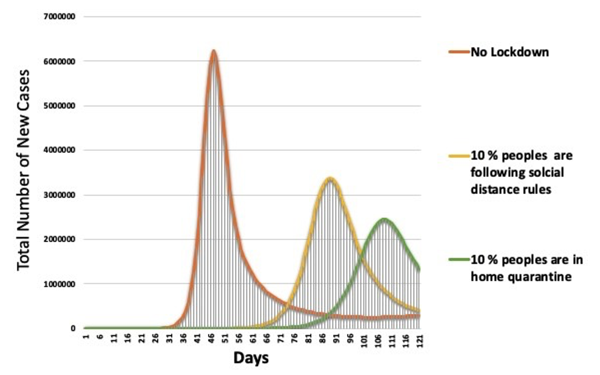
Figure 6 Comparison between all three cases, these figures indicates that among those three cases staying home can provide better result to protect people from infections from the Coronavirus.
A mathematical model is useful to find basic reproduction number,
. Our main goal to decrease the value of
using our mathematical model. From the equation 7 we can see, apart from some important parameters
, there are other parameters also plays important rule to decrease the
value. Such as, increasing incubation period may decrease the infective people, which can decrease the basic reproduction number as well.
Restrictions
Since based on our model,
depends one many parameters. That needs more real data to predict more accurately. When we are researching for the case of Bangladesh, we haven’t find some important parameter values, such as, we don’t know what is the probability (
in our model) that quarantined people become susceptive. So, we assumed it is 50%. But, it can be 0% or can be 100%. At this time, we don’t know what is the mean period of time that we can say perfectly in how many days or hours quarantined people is becoming susceptive. So, we have assumed it is on an average of seven days
. But, real situation can be much worse or much better. And this situation is same for finding community transmission rate from recovered people to get susceptive again. That is finding the value of
.
Conclusion
We have developed our model based on the thinking of what should do when an outbreak occur in a developing country or a country that is under poverty level by the World Bank’s country designations. Cause, usually to face an outbreak is costly due to provide medical facility to the nation. For our data source, we have picked a developing country namely Bangladesh, which is a second largest densely populated country as well. Our modelling basic reproduction number,
of COVID-19 coronavirus shows that, currently there is a serious concern of outbreaking situation in Bangladesh to spread this novel coronavirus in huge number of population. Bangladesh has limited resources to face this outbreak. At this time, a well strategy can control faster from spreading the virus and protect the nation. We have found, a three weeks lockdown can decrease the reproduction number of this novel coronavirus from now on (figure-7(top)). We also shown, for a developing country like Bangladesh, mass peoples are also responsible to reduce this virus by following the WHO guidance and following social distance (see figure-7(middle)). Also, we have found people can take the responsibility to make their home as a quarantine place that could decrease spreading the virus rapidly (see figure-7 (bottom)).
Acknowledgments
This study was partially supported by Grant-in-Aid for Scientific Research from JSPS, Japan, KAKENHI (Grant No. JP 19KK0262) awarded to Professor Tanimoto.
Conflicts of interest
The authors declare that they have no conflict of interest.
References
- World Health Organization. Coronavirus. World Health Organization cited. 2020.
- Zhou P, Yang XL, Wang XG, et al. A pneumonia outbreak associated with a new coronavirus of probable bat origin. Nature. 2020;579:270‒273.
- Huang C, Wang Y, Li X, et al. Clinical features of patients infected with 2019 novel coronavirus in Wuhan, China. Lancet. 2020;395(10223):497‒506.
- Li Q, Guan X, Wu P, et al. Early transmission dynamics in Wuhan, China, of novel coronavirus-infected pneumonia. N Engl J Med. 2020;382:1199‒1207.
- Coronavirus pandemic in Bangladesh. 2020.
- https://www.iedcr.gov.bd
- Kermack WO, McKendrick AG.A contribution to the mathematical theory of epidemics. Proc Roy Soc of London, Series A. 1927; 115(772):700‒721.
- May Robert M, Anderson Roy M. Infectious diseases of humans: dynamics and control. Oxford: Oxford University Press. 1991.
- Li MY, Muldowney JS. Global stability for the SEIR model in epidemiology, Math Bio. 1995;125(2):155‒164.
- Feng Z. Final, Peak Epidemic sizes for SEIR models with quarantine and isolation. Math Biosci Eng. 2007;4(4):675‒686.
- Safi MA, Imran M, Gumel AB. Threshold dynamics of a non-autonomous SEIRS model with quarantine and isolation. Theory Biosci. 2012;131(1):19‒30.
- Yongzhen P, Shaoying L, Shuping L. A delayed SEIQR epidemic model with pulse vaccination and the quarantine measure, Comp. and Math. with App. 2009;58(1):135‒145.
- Kabir KM A, Kuga K, Tanimoto J. Analysis of SIR epidemic model with information spreading of awareness. Cha Sol and Frac. 2019;119:118‒125.
- Kabir KM A, Tanimoto J. Analysis of epidemic outbreaks in two-layer networks with different structures for information spreading and disease diffusion, Comm Non Sci Nun Sim. 2009;72:565‒574.
- Kabir K M A, Tanimoto J. Impact of awareness in metapopulation epidemic model to suppress the infected individuals for different graphs, European Physical Journal B. 2019;92:199.
- Kabir K M A, Jusup M, Tanimoto J. Behavioral incentives in a vaccination-dilemma setting with optional treatment. Physical Review E. 2019;100(6–1):062402.
- Alam M, Kabir K M A, Tanimoto J. Based on mathematical epidemiology and evolutionary game theory, which is more effective: quarantine or isolation policy? J state. 2020;033502.
- G A Ngwa, M I Teboh-Ewungkem. A mathematical model with quarantine states for the dynamics of Ebola virus disease in human populations. Comput Math Methods Med. 2016;9352725.
- Chen T, Ka-Kit Leung R, Liu R, et al. Risk of imported Ebola virus disease in China. Travel Med Infect Dis. 2014;12(6):650‒658.
- Zhang S, Hu Q, Deng Z, et al. Transmissibility of acute haemorrhagic conjunctivitis in small-scale outbreaks in Hunan Province, China. Sci Rep. 2020;10:119.
- Chen S, Yang D, Liu R,et al. Estimating the transmissibility of hand, foot, and mouth disease by a dynamic model. Public Health. 2019;174:42‒48.
- Cui J-A, Zhao S, Guo S, et al. Global dynamics of an epidemiological model with acute and chronic HCV infections. Appl Math Lett. 2020;103:106203.
- Liangrong Peng, Wuyue Yang, Dongyan Zhang, et al. Epidemic analysis of COVID-19 in China by dynamical modeling, medRxiv. 2020.
- Chen T, Rui J, Wang Q. et al. A mathematical model for simulating the phase-based transmissibility of a novel coronavirus. Infect Dis Poverty. 2020;9(24).
- Li Q, Guan X, Wu P, et al. Early transmission dynamics in Wuhan, China, of novel coronavirus-infected pneumonia. N Engl J Med. 2020;382:1199‒1207.

©2021 Chowdhury, et al. This is an open access article distributed under the terms of the,
which
permits unrestricted use, distribution, and build upon your work non-commercially.








